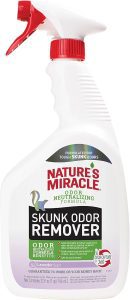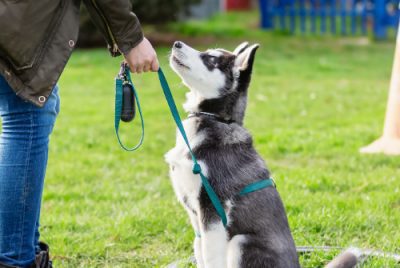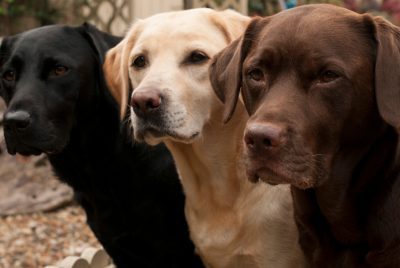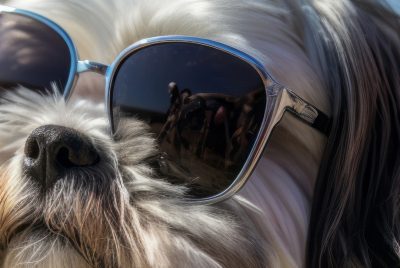Skunk Spray: Emergency Actions for Dog Owners
Post Disclaimer
We may earn a commission for purchases made using our links. Please see our Disclaimer to learn more.
My Dog Got Sprayed By A Skunk: What To Do Next
Key Highlights
- Skunk spray can cause eye irritation in dogs, and in rare cases, it can lead to temporary blindness and anemia.
- Immediate action is necessary after your dog gets sprayed to minimize the effects of skunk spray.
- Safety measures such as wearing rubber gloves and safety goggles should be taken before treating your dog.
- Cleaning involves using a skunk odor remover and cool water to remove the skunk smell from your dog’s fur.
- A homemade de-skunking solution can be prepared using hydrogen peroxide, baking soda, and dishwashing liquid.
- Applying the solution requires using rubber gloves and ensuring that the solution does not come in contact with the dog’s eyes, face, or ears.
- After applying the solution, rinse your dog with warm water and observe for any skin reactions.
- In severe cases, professional care may be required, and monitoring your dog for any potential health issues is important.
- Preventive measures such as securing your property and training your dog can help avoid future skunk encounters.
Introduction
Encountering a skunk is never a pleasant experience, especially when your furry friend gets sprayed. Skunk spray is notorious for its pungent odor, which can be difficult to eliminate. If your dog has been sprayed by a skunk, it’s important to act quickly to minimize the effects of the spray and ensure your dog’s comfort. This blog will discuss what you should do after your dog gets sprayed by a skunk.
Skunk spray is a defense mechanism skunks use to ward off potential threats. The spray is produced by the skunk’s anal glands and contains sulfurous chemicals that give it its distinct smell. When a skunk feels threatened, it releases an oily spray that can reach its target up to 15 feet away. This spray can cause eye and skin irritation in dogs and can even lead to temporary blindness and anemia in severe cases.
Understanding Skunk Spray and Its Effects on Dogs
Skunk spray is composed of sulfurous chemicals that give it its distinct smell. The spray is a defense mechanism skunks use to ward off potential threats. When a skunk feels threatened, it releases an oily spray from its anal glands. This spray can cause eye and skin irritation in dogs and can have temporary effects such as vomiting and even temporary blindness. Understanding the nature of skunk odor and its effects on dogs is important to decontaminate your furry friend effectively.
The Nature of Skunk Odor
Skunk odor is known for its pungent and persistent smell. The secretions from a skunk’s anal glands contain sulfurous chemicals called thiols and thioacetates. Thiols are immediately pungent and give skunk spray its distinct smell. Conversely, thioacetates are not initially smelly but convert to thiols when mixed with water. This is why the skunk smell can linger on a dog’s fur even after being washed with water. Understanding the nature of skunk odor is important to remove it from your dog effectively.
Immediate Reactions in Dogs
When a dog gets sprayed by a skunk, it can experience immediate reactions such as eye irritation, skin irritation, temporary blindness, and even vomiting. The sulfurous chemicals present in the skunk spray can cause irritation and discomfort to the dog’s eyes and skin. If the dog inhales the spray or gets it in its mouth, it can lead to respiratory irritation and nausea. In rare cases, the skunk spray can cause anemia by damaging the dog’s red blood cells. Taking immediate action after your dog gets sprayed is important to minimize these immediate reactions and ensure its well-being.
First Response After Your Dog Gets Sprayed
The first response after your dog gets sprayed by a skunk is crucial in minimizing the effects of the skunk’s spray. It is important to take immediate action to prevent further discomfort and to remove the skunk odor from your dog’s fur. Safety measures should be taken before treating your dog, such as wearing rubber gloves and safety goggles to protect yourself. The initial cleaning steps involve using a skunk odor remover and cool water to remove the skunk smell from your dog’s fur.
Remember, skunks produce their spray as a defense mechanism, and it contains sulfurous chemicals called thiols. Keeping your dog outside during the de-skunking process helps prevent the smell from permeating your house.
Safety Measures Before Treatment
Before treating your dog after being sprayed by a skunk, it is important to take some safety measures to protect yourself. Wear rubber gloves to prevent direct contact with the skunk spray and to avoid getting the odor on your hands. Safety goggles can also be worn to protect your eyes from any potential splashes. These safety measures ensure that you can effectively treat your dog without putting yourself at risk. Taking these precautions can safely and efficiently remove the skunk odor from your dog’s fur.
Initial Cleaning Steps
The initial cleaning steps are crucial in removing the skunk smell from your dog’s fur. Start by using a skunk odor remover, which can be purchased from a pet store, to break down the sulfurous chemicals in the skunk spray. Apply the skunk odor remover to your dog’s fur and thoroughly massage it into the affected areas. Use cool water to rinse off the skunk odor remover and the skunk spray from your dog’s fur. This initial cleaning process will help remove most of the skunk smell from your dog’s fur, making it easier to decontaminate your furry friend.
Preparing a Homemade De-Skunking Solution
If you prefer to use a homemade solution to de-skunk your dog, you can use a few ingredients to create an effective de-skunking solution. This homemade solution uses hydrogen peroxide, baking soda, and dishwashing liquid. These ingredients work together to neutralize the skunk odor and remove the oily residue from your dog’s fur. By preparing and applying this homemade de-skunking solution, you can effectively remove the skunk odor from your dog without the need for commercial products.
Necessary Ingredients
You will need a few key ingredients to prepare a homemade de-skunking solution. These include 1 quart of 3% hydrogen peroxide, 1/4 cup of baking soda, and 1-2 teaspoons of dishwashing liquid, such as Dawn. The hydrogen peroxide helps to neutralize the skunk odor, while the baking soda helps to remove the oily residue from your dog’s fur. The dishwashing liquid acts as a surfactant to help distribute the solution evenly on your dog’s fur. These ingredients can be easily found at your local grocery store or pharmacy, making it convenient to prepare the homemade de-skunking solution for your furry friend.
Step-by-Step Mixing Instructions
To mix the homemade de-skunking solution, follow these step-by-step instructions:
- Wear rubber gloves to protect your hands.
- If your dog’s eyes have been sprayed, rinse them with cool water.
- In a closed container, such as a bowl, mix 1 quart of 3% hydrogen peroxide, 1/4 cup of baking soda, and 1-2 teaspoons of dishwashing liquid.
- Mix the ingredients together until they are well combined and start to bubble.
- Immediately apply the solution to your dog’s fur, thoroughly massaging it into the affected areas.
- Be cautious to avoid the dog’s eyes, face, and ears.
- Let the solution sit on your dog’s fur for 5 minutes.
- Rinse the solution off your dog’s fur with warm water, ensuring that all of the solution has been thoroughly rinsed off.
- Repeat the process if necessary to completely remove the skunk odor from your dog’s fur.
Applying the De-Skunking Solution
Applying the de-skunking solution properly is important to ensure that it effectively removes the skunk odor from your dog’s fur. When applying the solution, it is essential to wear rubber gloves to protect your hands from the skunk spray and to prevent the odor from transferring to your skin. Thoroughly massage the solution into your dog’s fur, covering all areas that have been sprayed. Take care to avoid your dog’s eyes, face, and ears. Following the proper application method can effectively remove the skunk odor from your dog’s fur.
How to Properly Apply the Solution
To properly apply the de-skunking solution, follow these steps:
- Put on rubber gloves to protect your hands.
- If your dog’s eyes have been sprayed, rinse them with cool water.
- Thoroughly mix the homemade de-skunking solution in a closed container.
- Apply the solution to your dog’s fur, starting from the head and working your way down to the tail.
- Massage the solution into your dog’s fur, covering all areas that have been sprayed.
- Take extra care to avoid your dog’s eyes, face, and ears.
- Allow the solution to sit on your dog’s fur for about 5 minutes.
- Rinse your dog’s fur with warm water, ensuring that all of the solution has been thoroughly rinsed off.
- Repeat the process if necessary to completely eliminate the skunk odor from your dog’s fur.
Precautions During Application
While applying the de-skunking solution, it is important to take certain precautions to ensure the safety and comfort of your dog. Avoid getting the solution in your dog’s eyes, as the ingredients can cause irritation. Avoid the eyes and nose when applying the solution to your dog’s face. It is also important to avoid getting the solution in your dog’s ears, as this can lead to discomfort or irritation. By following these precautions, you can effectively de-skunk your dog without causing any additional discomfort or harm.
Post-Application Care
After applying the de-skunking solution, there are a few steps you can take to ensure proper post-application care for your dog. Start by rinsing your dog’s fur with warm water to remove any remaining solution. This helps to ensure that all of the skunk odor has been completely eliminated. You can then proceed to bathe your dog with a regular pet shampoo to leave their fur clean and fresh. Finally, towel dry your dog and allow them to finish drying in a warm area.
Rinsing and Drying Your Dog
Rinsing your dog thoroughly after applying the de-skunking solution is crucial to removing any residue and all skunk odor. Use warm water to thoroughly rinse your dog’s fur, removing any remaining solution. It is important to rinse your dog’s fur completely to avoid any lingering skunk smell. Once your dog has been rinsed, you can proceed to dry them. Towel dry your dog gently, removing excess moisture from their fur. It is advisable to allow your dog to finish drying in a warm area to avoid any discomfort or chill.
Observing for Any Skin Reactions
After treating your dog with skunk spray, observing their skin for any signs of irritation or reactions is important. Skunk spray can cause skin irritation, redness, and discomfort in some dogs. Monitor your dog’s skin closely for any signs of irritation, such as redness, swelling, or itching. If you notice any skin reactions, consult your veterinarian for further guidance. They may recommend additional care or treatment to alleviate any discomfort or irritation. By observing your dog’s skin and taking necessary precautions, you can ensure their well-being after being sprayed by a skunk.
Professional Care Options
In some cases, professional care may be necessary if your dog has been severely skunked or if they are experiencing any health issues after being sprayed. A veterinarian can properly treat and care for your dog, ensuring their well-being and addressing any potential complications. If your dog shows signs of anemia, such as weakness or pale mucous membranes, or if they have been heavily sprayed or exposed to skunk spray multiple times, it is recommended to seek veterinary care. A veterinarian can assess your dog’s condition and provide the appropriate care to ensure their recovery.
When to Visit a Veterinarian
While most cases of skunk spray can be treated at home, there are certain instances where it is necessary to visit a veterinarian. If your dog has been heavily sprayed by a skunk or has had multiple exposures to skunk spray, it is important to seek veterinary care. The veterinarian can assess your dog’s condition and provide the necessary treatment to alleviate any discomfort or health issues. Additionally, immediate veterinary care is essential if you suspect that the skunk may have been carrying rabies and your dog has been bitten. In rare cases, skunks can transmit rabies, and early intervention is crucial to prevent any potential complications.
Potential Health Issues to Monitor
After being sprayed by a skunk, it is important to monitor your dog for any potential health issues that may arise. Skunk spray can cause skin and eye irritation, leading to redness, swelling, or discomfort. Some dogs may experience temporary blindness or respiratory irritation if they inhale the skunk spray. In rare cases, skunk spray can lead to anemia, characterized by weakness, pale mucous membranes, and lack of appetite. Monitor your dog closely for any signs of these health issues, and seek veterinary care if necessary. You can ensure prompt recovery after a skunk encounter by staying vigilant and attentive to your dog’s well-being.
Preventive Measures Against Future Skunk Encounters
You can take several preventive measures to prevent future skunk encounters and minimize the risk of your dog getting sprayed. Secure your property by eliminating readily available food sources and blocking access to sheds, decks, or porches where skunks may seek shelter. Be cautious when letting your dog out in the yard during dawn and dusk, as skunks are most active during these times. Consider training your dog to avoid skunks and keep them on a leash when in areas known for skunk encounters. By implementing these preventive measures, you can reduce the likelihood of your dog encountering a skunk.
Secure Your Property
Securing your property is an effective way to minimize the risk of skunk encounters. Skunks are attracted to readily available food sources, such as pet food or garbage, so it is important to eliminate these food sources from your yard. Keep pet food indoors or in secure containers, and ensure that garbage or compost heaps are inaccessible to skunks. Additionally, block access to sheds, decks, or porches, as these areas can provide shelter for skunks. By securing your property and removing potential attractions, you can create a less appealing environment for skunks and reduce the likelihood of encountering them.
Training Your Dog to Avoid Skunks
Training your dog to avoid skunks can be an effective preventive measure. Teach your dog to respond to commands, such as “leave it” or “come,” to avoid potential encounters with skunks. Keep your dog on a leash when walking in areas known for skunk sightings, such as wooded areas or parks. Maintaining control over your dog’s movements can prevent them from approaching skunks. It is also important to be vigilant and aware of your surroundings when walking your dog to avoid skunk encounters. By training your dog and taking necessary precautions, you can reduce the risk of your dog getting sprayed by a skunk.
Conclusion
In conclusion, immediate action and proper care are crucial when your dog gets sprayed by a skunk. Key steps include understanding the skunk spray’s effects, following safety measures, and using a homemade de-skunking solution. Remember to observe your dog for any adverse reactions and seek professional care if needed. Preventive measures can also help avoid future skunk encounters. By being prepared and proactive, you can effectively manage and alleviate the discomfort caused by a skunk spray incident.
Frequently Asked Questions
What if the skunk spray gets into my dog’s eyes?
If the skunk spray gets into your dog’s eyes, it can cause swelling, redness, and even temporary blindness. Rinse your dog’s eyes with cool water to flush out the spray and provide relief. If the irritation persists, seek veterinary care.
How long will the skunk smell linger on my dog?
If not properly eliminated, the skunk smell can linger on your dog’s fur for a few months. Using a skunk odor remover or a homemade de-skunking solution can effectively remove the skunk smell from your dog’s fur.
Are there any commercial products as effective as homemade solutions?
Yes, commercial products, such as Nature’s Miracle Skunk Odor Remover, are available that can be as effective as homemade solutions in removing skunk odor from your dog’s fur.





